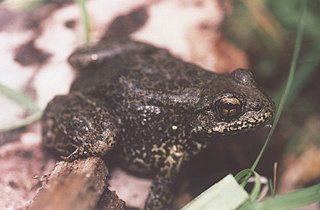
The African clawed frog, also known as the xenopus, African clawed toad, African claw-toed frog or the platanna) is a species of African aquatic frog of the family Pipidae. Its name is derived from the three short claws on each hind foot, which it uses to tear apart its food. The word Xenopus means 'strange foot' and laevis means 'smooth'.

Xenopus is a genus of highly aquatic frogs native to sub-Saharan Africa. Twenty species are currently described within it. The two best-known species of this genus are Xenopus laevis and Xenopus tropicalis, which are commonly studied as model organisms for developmental biology, cell biology, toxicology, neuroscience and for modelling human disease and birth defects.

Since the 1980s, decreases in amphibian populations, including population decline and localized mass extinctions, have been observed in locations all over the world. These declines are known as one of the most critical threats to global biodiversity.

Sir John Bertrand Gurdon is a British developmental biologist. He is best known for his pioneering research in nuclear transplantation and cloning. He was awarded the Lasker Award in 2009. In 2012, he and Shinya Yamanaka were awarded the Nobel Prize for Physiology or Medicine for the discovery that mature cells can be converted to stem cells.

Chytridiomycosis is an infectious disease in amphibians, caused by the chytrid fungi Batrachochytrium dendrobatidis and Batrachochytrium salamandrivorans. Chytridiomycosis has been linked to dramatic population declines or extinctions of amphibian species in western North America, Central America, South America, eastern Australia, east Africa (Tanzania), and Dominica and Montserrat in the Caribbean. Much of the New World is also at risk of the disease arriving within the coming years. The fungus is capable of causing sporadic deaths in some amphibian populations and 100% mortality in others. No effective measure is known for control of the disease in wild populations. Various clinical signs are seen by individuals affected by the disease. A number of options are possible for controlling this disease-causing fungus, though none has proved to be feasible on a large scale. The disease has been proposed as a contributing factor to a global decline in amphibian populations that apparently has affected about 30% of the amphibian species of the world. Some research found evidence insufficient for linking chytrid fungi and chytridiomycosis to global amphibian declines, but more recent research establishes a connection and attributes the spread of the disease to its transmission through international trade routes into native ecosystems.

The mountain yellow-legged frog, also known as the southern mountain yellow-legged frog, is a species of true frog endemic to California in the United States. It occurs in the San Jacinto Mountains, San Bernardino Mountains, and San Gabriel Mountains in Southern California and the Southern Sierra Nevada. It is a federally listed endangered species.

The boreal toad is the nominate subspecies of the western toad. They are commonly found in the Southern Rocky Mountains, and their population has recently been on the decline due to an emerging amphibian disease, chytrid fungus. The boreal toad is currently listed as an endangered species by Colorado and New Mexico. It is known in Colorado as the only alpine species of toad.

Batrachochytrium dendrobatidis, also known as Bd or the amphibian chytrid fungus, is a fungus that causes the disease chytridiomycosis in amphibians.
A panzootic is an epizootic that spreads across a large region, or even worldwide. The equivalent in human populations is called a pandemic.

Agalychnis lemur, the lemur leaf frog or lemur frog, is a species of frog in the subfamily Phyllomedusinae. It is found in Costa Rica, Panama, and adjacent northwestern Colombia. It is classed as Critically Endangered and threatened by the fungal disease chytridiomycosis.

The green-eyed treefrog is a species of Australasian treefrog in the subfamily Pelodryadinae that occurs in the Wet Tropics of Australia.

The western clawed frog is a species of frog in the family Pipidae, also known as tropical clawed frog. It is the only species in the genus Xenopus to have a diploid genome. Its genome has been sequenced, making it a significant model organism for genetics that complements the related species Xenopus laevis, a widely used vertebrate model for developmental biology. X. tropicalis also has a number of advantages over X. laevis in research, such as a much shorter generation time, smaller size, and a larger number of eggs per spawn.

The Sierra Nevada yellow-legged frog or Sierra Nevada Mountain yellow-legged frog is a true frog endemic to the Sierra Nevada of California and Nevada in the United States. It was formerly considered Rana muscosa until a 2007 study elevated the more central and northern populations to full species status, restricting R. muscosa to the southern Sierra Nevada and southern California.

The golden toad is an extinct species of true toad that was once abundant in a small, high-altitude region of about 4 square kilometres (1.5 sq mi) in an area north of the city of Monteverde, Costa Rica. It was endemic to elfin cloud forest. Also called the Monte Verde toad, Alajuela toad and orange toad, it is commonly considered the "poster child" for the amphibian decline crisis. This toad was first described in 1966 by herpetologist Jay Savage. The last sighting of a single male golden toad was on 15 May 1989, and it has since been classified as extinct by the International Union for Conservation of Nature (IUCN).
Xenbase is a Model Organism Database (MOD), providing informatics resources, as well as genomic and biological data on Xenopus frogs. Xenbase has been available since 1999, and covers both X. laevis and X. tropicalis Xenopus varieties. As of 2013 all of its services are running on virtual machines in a private cloud environment, making it one of the first MODs to do so. Other than hosting genomics data and tools, Xenbase supports the Xenopus research community though profiles for researchers and laboratories, and job and events postings.

Ecnomiohyla rabborum, commonly known as Rabbs' fringe-limbed treefrog, is a possibly extinct species of frog in the family Hylidae. They were relatively large frogs that inhabited the forest canopies of central Panama. Like other members of the genus Ecnomiohyla, they were capable of gliding by spreading their enormous and fully webbed hands and feet during descent. The males of the species were highly territorial and would guard water-filled tree holes used for breeding. They were also the ones responsible for guarding and caring for the young, including providing food. They were the only known species of frog where the tadpoles derived nutrition by feeding on the skin cells of their fathers.
Hillel Abbe Shapiro was a South African forensic pathologist with a range of specialisms in experimental physiology and forensic medicine. He was editor of medical journals, medical text books and a university lecturer.

Karen R. Lips is a Professor of Biology at University of Maryland, College Park. Lips' work in the 1990s eventually contributed to the identification of the chytrid fungus as the primary cause of frog decline worldwide.
Lee Berger, is an Australian biologist and veterinarian, who discovered during her PhD that the fungus Batrachochytrium dendrobatidis was responsible for the decline and extinction of hundreds of amphibian species.
The frog test is a pregnancy testing method relying on frogs to show the pregnancy status of women. Provided that immunological pregnancy tests were not yet developed before 1960s, women living a century ago relied on urine-based pregnancy tests using different animals, ranging from mice to frogs. Nowadays, the advancement in medical technology has enabled women to accurately check their pregnancy status by using 'pee-on-a-stick' pregnancy test kits at home. Before these accessible and convenient test kits were invented, scientists strived to discover a way in spotting pregnancy-related hormones by a natural, simple test, where animals were often included as clinical tools to facilitate the process. The frog test or frog pregnancy test is one of the past prevalent pregnancy scanning methods.














